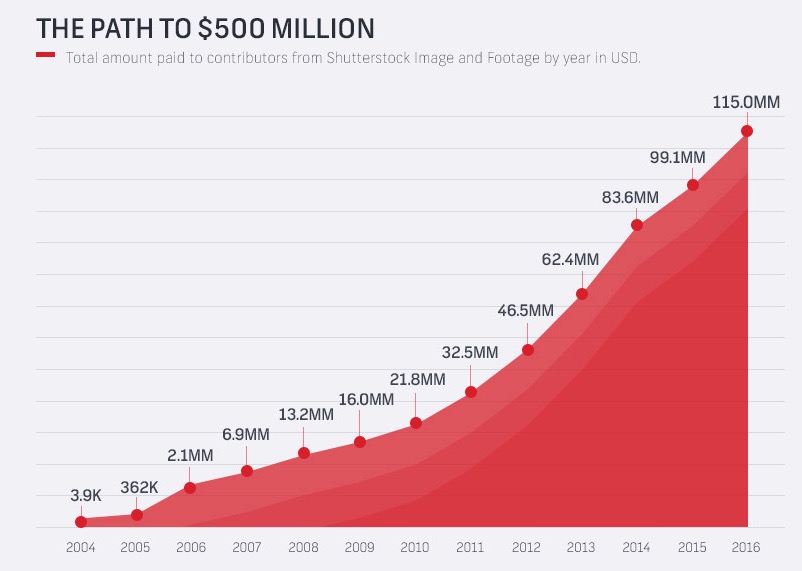When you think of Shutterstock, you probably picture that vast library of photos, vectors, and videos used by creators worldwide. But behind the scenes, there’s a whole system that makes sure contributors are fairly compensated whenever their work is licensed. Data licensing, in particular, has become a crucial part of Shutterstock’s business model, enabling users to access valuable data sets for various projects. For contributors, understanding how this process works can be a game-changer in knowing how they earn and how their work gets tracked and paid for. Let’s dive into the world of
How Shutterstock Tracks and Manages Data Licensing Sales
Shutterstock has developed a sophisticated system to track and manage data licensing sales, ensuring that contributors are paid accurately and promptly. When someone licenses a data set, whether it’s a single image, a collection, or a specific data package, the platform records these transactions in real time. Here’s how it works:
- Unique Identifiers: Every piece of content—be it an image, video, or data set—is assigned a unique ID. This helps the system keep precise records of each licensing event.
- Sales Tracking: When a customer purchases a license, the platform logs the sale, including details like the type of license, price, date, and purchaser’s information.
- Royalty Calculations: Based on the license type and the contributor’s agreement, Shutterstock calculates the royalty owed. The percentage can vary depending on factors like the contributor’s royalty rate or the type of license issued.
- Dashboard & Reporting: Contributors have access to dashboards that display sales data, licensing history, and earnings. This transparency helps contributors see exactly how their data is performing in the marketplace.
Additionally, Shutterstock employs advanced tracking tools and algorithms to monitor licensing activity globally. This ensures that each license is accounted for, even when sales occur across different regions or through third-party platforms. The system is designed to prevent fraud and double counting, so contributors can trust that their earnings are accurate.
Once a sale is confirmed, the platform updates the contributor’s account balance accordingly. Payments are typically processed on a monthly schedule, with clear records of each transaction. This meticulous management of licensing data not only benefits contributors by ensuring fair pay but also helps Shutterstock maintain a reliable and trustworthy marketplace for data licensing transactions.
Revenue Sharing Model for Shutterstock Contributors
When it comes to earning money on Shutterstock, understanding the revenue sharing model is key. Essentially, Shutterstock pays contributors a percentage of the revenue generated from licensing their content. But that percentage isn’t the same for everyone—it varies based on several factors like the contributor’s contributor level, the type of license purchased, and whether the customer is a subscriber or a one-time buyer.
Shutterstock operates on a split system, where the platform takes a portion of the licensing fee, and the rest goes to the contributor. Typically, contributors earn around 30-40% of the license fee for standard licenses, but this can increase if you’re a top contributor or have a higher contributor level. The more you contribute and the higher your reputation, the better your revenue share can become.
Here’s a quick overview of how the revenue sharing works:
- Standard License: Contributors usually earn approximately 30-40% of the license fee.
- Enhanced License: Might offer a slightly higher percentage, depending on the agreement.
- Subscription vs. On-Demand: Revenue sharing can differ based on whether the customer licenses through a subscription plan or purchases an on-demand license. Generally, subscription licenses generate a smaller payout per download, but volume can compensate for that.
Another important aspect is the contributor level system, which rewards consistent quality and volume of submissions. As you progress from a Standard Contributor to a Premium or Exclusive Contributor, your share of the revenue can increase. Exclusive contributors, who only submit their content to Shutterstock, often enjoy higher royalty rates because they give the platform exclusive rights to their work.
To sum it up, the revenue sharing model is designed to motivate high-quality, consistent contributions, and reward top performers with better payout rates. It’s a win-win: the platform gets fresh, high-quality content, and contributors earn more as their reputation grows.
Payment Structure and Frequency for Contributors
Now that you understand how Shutterstock shares revenue, let’s talk about how and when you actually get paid. Knowing the payment structure and schedule helps you plan your earnings and stay motivated.
First off, Shutterstock processes payments on a monthly basis. Once you hit the minimum payout threshold—which is typically $35—you become eligible for a payout. That means if you earn $35 or more in a month, Shutterstock will send you your earnings during the following payout cycle.
Here’s a quick breakdown of the payment process:
| Step | Details |
|---|---|
| 1. Accumulate earnings | Earn royalties from licensing your content. Earnings are credited to your account daily. |
| 2. Reach payout threshold | Once your earnings reach at least $35, you become eligible for payout. |
| 3. Payout processing | Shutterstock processes payouts once a month, usually around the 15th of each month. |
| 4. Payment methods | You can choose from several options, including PayPal, Skrill, or bank transfer, depending on your country. |
It’s worth noting that the processing time after the payout date can vary depending on your payment method. For example, PayPal transactions are usually instant or take a few hours, while bank transfers might take a few business days.
Also, keep in mind that Shutterstock has a policy of holding earnings for a certain period if there are concerns about fraud or suspicious activity. But generally, once your account is in good standing, you can expect your payments to arrive on schedule each month.
In summary, Shutterstock’s payment structure is straightforward: earn at least $35, and then receive your earnings monthly through your preferred payment method. Staying consistent with your uploads and understanding this cycle can help you maximize your earnings and keep your motivation high as a contributor.
Factors Influencing Contributor Earnings on Shutterstock
When it comes to earning money on Shutterstock through data licensing, there are several key factors that can really make a difference. Understanding these can help you optimize your contributions and boost your income potential. Let’s dive into the main elements that influence your earnings as a contributor.
1. License Type
Shutterstock offers different types of licenses—Standard and Enhanced. Standard licenses are more affordable for buyers and come with lower royalty rates, while Enhanced licenses are pricier and offer higher payouts. The type of license purchased directly impacts how much you earn per download.
2. Contributor Tier and Portfolio Quality
Shutterstock has a tier system that rewards consistent contributors with higher earning rates. The more high-quality, diverse, and popular your portfolio becomes, the higher your potential earnings. Quality content that aligns well with market demand tends to generate more licensing sales.
3. Buyer Location and Usage
Where the buyer is located can influence licensing fees and, consequently, your earnings. For example, licenses purchased in certain regions may command different prices based on local market conditions or usage rights. Additionally, commercial use licenses generally pay more than editorial uses.
4. Market Demand and Trends
Trending topics, seasonal content, and niche subjects tend to sell better. Keeping an eye on market trends and creating relevant, in-demand data can increase your chances of earning more over time.
5. Number of Downloads
Ultimately, the more your data is downloaded and licensed, the more money you make. Building a large, appealing portfolio and promoting your work can lead to more downloads, especially if your content is optimized for search and discovery.
6. Licensing Model and Revenue Share
Shutterstock’s licensing model is designed to reward contributors based on their contributor level and the volume of sales. As you grow your portfolio and sales, your revenue share can improve, leading to higher earnings per license.
Tips to Maximize Earnings from Data Licensing on Shutterstock
If you’re looking to boost your income from data licensing, here are some practical tips that can help you make the most of your contributions on Shutterstock:
- Create High-Quality, Relevant Data: Focus on producing detailed, accurate, and clear datasets that meet the needs of buyers. Well-organized data with proper annotations and metadata will stand out and increase your chances of licensing.
- Stay on Top of Trends: Keep an eye on emerging industries and popular topics. For example, data related to renewable energy, AI, or healthcare might be in high demand. Creating trending data can lead to more downloads.
- Optimize Metadata and Keywords: Use descriptive, accurate keywords and tags to improve discoverability. Think about what buyers might search for and include relevant terms to make your data easier to find.
- Diversify Your Portfolio: Don’t put all your eggs in one basket. Offer a variety of data types, subjects, and formats to appeal to a broader audience and increase licensing opportunities.
- Maintain Consistency and Regular Uploads: Regularly adding fresh data keeps your portfolio active and attractive to buyers. Consistent uploads can also improve your ranking within Shutterstock’s contributor system.
- Engage with the Contributor Community: Join forums, webinars, and social media groups to learn best practices, get feedback, and stay motivated. Networking can open up new ideas and opportunities.
- Monitor Your Performance and Adjust: Use Shutterstock’s analytics to see which data sells best. Focus on creating similar content or improving underperforming items to maximize your earnings.
Remember, building a successful licensing portfolio takes time and effort. By understanding what influences your earnings and applying these tips, you’ll be well on your way to making the most of your data contributions on Shutterstock. Happy licensing!
Conclusion and Final Thoughts on Shutterstock Contributor Payments
Understanding how Shutterstock compensates contributors is essential for anyone looking to succeed in the platform’s data licensing ecosystem. Shutterstock offers a transparent and structured payment system that rewards contributors based on several factors, including their exclusive status, the type of license purchased, and the total earnings accumulated over time. By consistently uploading high-quality, diverse, and license-ready data, contributors can maximize their earning potential.
Key points to keep in mind include:
- Royalty rates vary: Contributors earn between 15% to 40% per sale, depending on their exclusivity and the type of license.
- Referral bonuses: Shutterstock offers additional incentives for referring new contributors or customers.
- Payment methods: Earnings are typically paid via PayPal or bank transfer once a minimum threshold is met.
- Consistent uploads and quality: Regularly contributing high-quality data can lead to higher earnings and more visibility on the platform.
Overall, success on Shutterstock depends on a combination of strategic uploading, understanding licensing nuances, and maintaining a steady flow of valuable data. By staying informed about the payment structure and actively engaging with the platform’s guidelines, contributors can optimize their revenue streams and build a sustainable licensing business.
In conclusion, Shutterstock provides a fair and rewarding system for its contributors, rewarding quality and consistency. With the right approach, contributors can turn their data assets into a reliable source of income while contributing to a vibrant global marketplace of digital content.



